キリンソウと四季の彩り日記屋上緑化システム株式会社
技術顧問 山下 律正
四季彩4 キリンソウ 総合技術カタログ A new variety, Shikisai 4 Kirinsou,General Technical Catalog
四季彩4 キリンソウ(種苗登録No31067号)総合技術カタログ
Sikisai 4 Seedling registration application No34723 General Technical Catalog
四季彩4 キリンソウが種苗登録されました。
これまでのキリンソウより濃緑で耐候性の強さが特徴の新しいタケシマキリンソウの突然変異種です。
キリンソウを使った緑化に求められる特性は、耐候性、猛暑耐性、薄層土での生育、強風耐性が求められます。四季彩4キリンソウはこれらの異常現象に耐える品種として開発しました。その特徴を紹介します。
A new variety, Shikisai 4 Kirinsou, has been registered.
This is a new Phedimus takesimensis( Nakai) mutant that is darker green than previous Kirinsou varieties and has excellent weather resistance.The characteristics required for greening using Kirinsou are weather resistance, tolerance for extreme heat, the ability to grow in limited soil, and resistance to strong winds. Shikisai 4 Kirinsou was developed as a variety that can withstand these abnormal phenomena. We will feature its characteristics.


四季彩4キリンソウ(種苗登録No31067号)
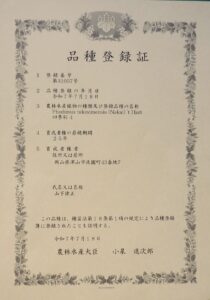

猛暑・乾燥・暴風雨に耐えるタフな四季彩4キリンソウの特徴
Characteristics of the tough Shikisai 4 Kirinsou plant that can withstand extreme heat, dryness, and storms
目次
第1回 特長紹介
Part 1: Introduction to Features
第2回 根を露出した裸状態での耐候性・生存限界
Part 2: Weather resistance and survival limits when the roots are exposed
第3回 猛暑・防風・豪雨にも負けない
Part3: Unbeatable in extreme heat, wind and heavy rain
第4回 緑化でどれくらい涼しくなるのか?
Part 4: How much cooler can greening make the place?
第5回 高温耐性について
Part 5: High temperature resistance
第6回 四季彩4キリンソウの色調と新芽成長の仕方
Part 6: Shikisai 4: Color and growth of new shoots of the kirinsou plant
第7回 キリンソウの常緑とは
Part 7: What is the evergreen nature of the Kirinsou?
第7回 高温に耐える屋上緑化植物にする培土の工夫
Part 7: How to make rooftop green plants resistant to high temperatures
第8回 高温に耐える屋上緑化植物にする培土の工夫
Part 8: How to make rooftop green plants resistant to high temperatures
第1回
特長紹介 Part 1: Introduction to Features
★特 徴 Feature
1 種苗登録品種(種苗登録No31067号)Seedling registration variety (Seedling registration No. 31067)
2 常緑性、強健、大型キリンソウ Evergreen, hardy, large P. takesimensis( Nakai)
3 濃緑、厚葉が特徴のキリンソウ P. takesimensis( Nakai) is characterized byits dark green color and thick leaves.
4 耐候性はキリンソウ種で最高 It has the best weather resistance of all the gypsophila species.takesimensis( Nakai)
5 メンテナンスは常緑性キリンソウと同じ Same maintenance as evergreen P. takesimensis( Nakai)
★特 性
草姿 :直立型
色 :濃緑色
草丈 :30cm ~ 50cm
開花時期 :8月~10月
落葉時期 :12月
新芽の生長季節 :10月頃
植栽数 :50cm角トレー:4pot/トレー 路地植え:20pot/㎡
information
Plant shape : Upright type
Color : dark green color
Plant height : 30cm to 50cm
Flowering period : August to October
Autumn leaves : December
Growth period of sprout s: Around October
Number of plants : 50 cm square tray 4 pots/tray Alley planting: 20 pots/m2
★生存限界試験
キリンソウは屋上緑化の潅水が無く、メンテナンスができない条件の場所に使用される緑化植物です。使命は猛暑・寒冷・暴風・放任の悪条件でも生育を続ける事が求められています。これらの悪条件を生き抜く試験として、根に付いている土壌を高圧洗浄で洗い落とし、露天コンクリート上に放置していつまで生存するか試験しました。四季彩4キリンソウは479日経過でも成長サイクルを維持して生存しています。詳しくは第2回で解説します
Kirinsou is a greening plant used in places where there is no irrigation for rooftop greening and maintenance is not possible. Its mission is to continue growing even in adverse conditions such as extreme heat, cold, strong winds, and neglect. To test whether it can survive these adverse conditions, the soil attached to the roots was washed off with a high-pressure washer, and it was left on exposed concrete to test how long it would survive. Shikisai 4 Kirinsou has maintained its growth cycle and survived even after 479 days. More details will be explained in Part 2.
試験開始 2024年3月30日 Test start date: March 30, 2024


77日経過 2024年6月16日 枝は成長し草姿を整える
77 days have passed, June 16, 2024. The branches have grown and the plant has taken shape.
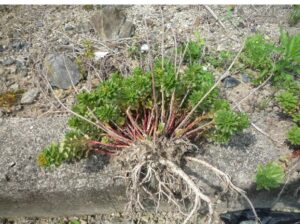

132日経過 2024年8月12日 コンクリート上で2024年の酷暑でもしっかり成長を続ける生命力がある
132 days have passed, August 12, 2024. Even on concrete, even in the extreme heat of 2024, the plant has the vitality to continue growing.
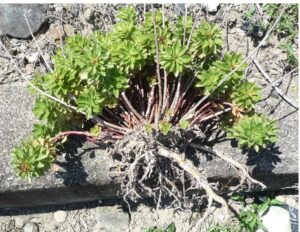

猛暑期でも葉色は濃緑色2024年8月12日
The leaves remain dark green even during the hottest seasons. August 12, 2024


在来種との葉色の違い 6月~7月 Difference in leaf color from native species
四季彩4 キリンソウは、タケシマキリンソウを化学突然変異技術で品種改良した新品種です。
その特徴の一つに「葉色」があります。屋上緑化では健康に見える葉色が良好な屋上緑化と誰の目にも映り内ります。四季彩4キリンソウは、初夏より晩秋の葉色は特に鮮明な「濃緑色」に近い色に変化します。
この色の違いは、市販キリンソウと比較しても判る色調となり緑化が冴えます。
色調の差は条件により変動し、成長期、耐性期には一般種に近くなります。
Shikisai 4 Kirinsou is a new variety created by breeding Takeshima Kirinsou using chemical mutation technology.
One of its distinctive features is its leaf color. When it comes to rooftop greenery, healthy-looking leaf color is a sure sign of good rooftop greenery. The leaf color of Shikisai 4 Kirinsou changes to a particularly vivid, almost dark green color from early summer to late autumn.This color difference is noticeable when compared to commercially available Kirinsou, making the greenery stand out.The Resistant period depending on conditions, and during the growth and tolerance periods it becomes closer to the general species.
左:タケシマキリンソウ 右:四季彩4キリンソウ
Left: Phedimus takesimensis( Nakai) Right: Shikisai 4 Kirinsou



★耐暑性比較 2024年8月12日 ★Heat resistance comparison August 12, 2024
猛暑・少雨の中で四季彩4 キリンソウと市販キリンソウの耐暑性を比較した、地球温暖化で猛暑の日数・高温が増加する中でキリンソウでも障害が発生する。では障害は植物体のどこにどのように発生するのかを検証する。
We compared the heat tolerance of Shikisai 4 Kirinsou and commercially available Kirinsou in extreme heat and little rain. If global warming increases the number of days of extreme heat, high temperatures, and little rain, even Kirinsou will suffer damage. We will now examine where and how the damage occurs in the plant body.
四季彩4 キリンソウ 2024年8月12日 Shikisai 4 Kirinsou August 12, 2024
花序の枯れも少なく、株元もしっかり根づいている
There are few withered inflorescences, and the base of the plant is firmly rooted.
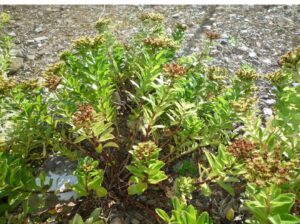



比較:市販のキリンソウ 2024年8月12日
新芽に障害が出やすい
新しい茎に障害が出やすい
The stems of new shoots are prone to damage。Commercially available kirinsou August 12, 2024 New shoots are prone to damage.
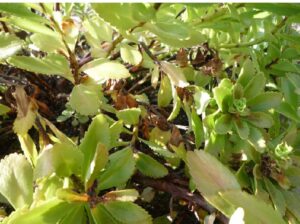



★生命の根源 根の生育 ★The source of life: root growth
タケシマキリンソウの根については、”化学突然変異育種 実験講座”7 根の変異2:タケシマキリンソウの自然種と突然変異種の違いで解説した
タケシマキリンソウは海岸部の岩場や岩のくぼ地、道路側面の土溜まりの土壌層数センチの場所が多いこのような場所で生育するに最大の問題は水分の確保である。キリンソウは機構的にCAM構造で水分保持に対応していても根の役割は重要である。 「四季彩4キリンソウ」を 砕石土に植栽すると砕石をよけながら伸長するため根は太く6mm以上になり、地表から40cm範囲に数センチ深さで広がり地面にしっかり根付く。
Origin of life Root growth The roots of Phedimus takesimensis( Nakai) were explained in the “Experimental lecture on chemical mutation breeding” 7 Root mutation 2: Differences between natural and mutant varieties of Phedimus takesimensis( Nakai) want to see Takeshima giraffes are often found in places where the soil layer is a few centimeters deep, such as coastal rocks, rocky depressions, and roadside puddles. The biggest problem in growing in such places is securing moisture. Phedimus has a CAM structure mechanically for water retention, but the role of the root is important.The roots of Shikisai 4 are thicker than 6 mm because they grow while avoiding crushed stones in crushed stone soil, and are firmly rooted in the ground, spreading to a depth of several centimeters within a range of 40 cm from the ground surface.
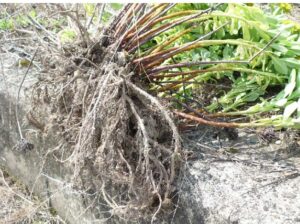

キリンソウを緑化容器で栽培すると、盛んに成長し水分を求めて排水口から根が出る。このため四季彩4キリンソウを屋上緑化で使用するには、緑化容器は耐根シートの上に設置が必須である
When light soil is placed in a greening tray and cultivated, the roots come out of the drainage holes in search of moisture.For this reason, in rooftop greening, it is essential to install a greening tray on top of the anti-root sheet in order to prevent cracks in the waterproof layer from penetrating into the building structure.
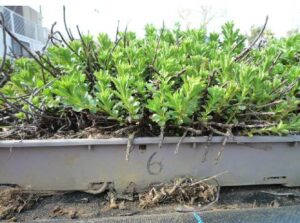

★早春の生長 early spring growth
四季彩4キリンソウは常緑性種で新芽の生長が前年秋に開始する
この成長の仕方は、開発原種のタケシマキリンソウの新芽の成長の仕方を引き継いでおり、市販キリンソウの「常緑」と同じ性質を持つ。
四季彩4キリンソウの茎の成長仕方は、写真でも判るように株元より直線的な成長となる。この成長は条件により松の枝状に短く脇芽が出て松の盆栽状に枝張する事も有る。株元よりの新芽発生は、写真のように集中して発生し直線状に放射状に成長するので緑被面積が広くなる。草丈が高く日影を広く作ると同時に、茎は長く風通しが良く、梅雨時期に発生する蒸れによる枯損被害も無い、また風通しによる屋上面の冷却効果も高い。
Shikisai No. 4 is an evergreen plant, and sprouts begin to grow in the fall of the previous year.
This growth pattern is inherited from the growth of new shoots of the original developed species, Takeshima Kirinsou, and has the same properties as the “evergreen” variety of commercially available Kirinsou.As can be seen in the photo, the stems of Shikisai 4 Kirinsou grow in a straight line from the base of the plant. Depending on the conditions, this growth can produce short side shoots resembling pine branches, spreading out like a pine bonsai.New shoots emerge from the base of the plant in a concentrated manner, as can be seen in the photo, and grow in a straight line, resulting in a wide green area, a tall plant, and widespread shade. At the same time, the long stems allow for good ventilation, preventing damage from humidity during the rainy season, and the ventilation also has a great cooling effect on rooftops.
10月27日 October 27th
来年春に成長する新芽が成長開始 New shoots that will grow next spring have begun to grow.


12月19日 December 19th
氷点下10度でも枯死しない Will not die even at minus 10 degrees


1月24日 January 24th
冬至芽(越冬する新芽)が成長を始める Winter solstice buds (overwintering buds) begin to grow


3月21日 March 21
草丈8cm付近まで成長 Grows up to around 8 cm tall


第2回
根を露出した状態での耐候性・生存限界試験
四季彩4 キリンソウの根が露出した状態で酷暑耐性・乾燥耐性・低温耐性・自然降雨のみの環境下での生存試験を実施した。
Weather resistance and survival limit test with roots exposed
Shikisai 4 Kirinsou’s roots were exposed and tested for extreme heat tolerance, drought tolerance, low temperature tolerance, and survival in an environment with only natural rainfall.
キリンソウを使った緑化に求められる特性は、耐候性、酷暑耐性、薄層土での生育、強風耐性、少雨での生育が求められます。四季彩4キリンソウはこれらの異常現象に耐える品種として開発しました。
その特性を判断するために根が露出した状態で、降雨が植物表面に降り乾燥するまでが吸水できる時間です。次回降雨まで給水が無いサボテン自生地と同じ過酷な条件を設定して行った。
試験は岡山県津山市にて2024年3月30日から、どれだけ枯損までの耐える事ができるのかの生存限界試験を行った。
試験開始より183日目に屋上緑化の実際に合わすために黒色緑化トレーに変更した。これは実際の施工環境では、プラスチックトレーに植栽設置される場合がほとんどで、容器色調は高温になる黒色を使用し、この中心部に移設して継続試験を実施した。
The characteristics required for greening using Phedimus takesimensis are weather resistance, extreme heat resistance, ability to grow in thin soil, resistance to strong winds, and ability to grow in low rainfall. Shikisai 4 Kirinsou was developed as a variety that can withstand these abnormal phenomena.To determine its characteristics, we restricted the water supply necessary for survival by limiting water absorption through the roots, creating the same harsh conditions as those found in the cactus’s natural habitat.The test began on March 30, 2024 in Tsuyama City, Okayama Prefecture, and was a survival limit test to determine how long the plants could withstand before dying.On the 183rd day after the test began, the plants were changed to black greening trays to match the reality of rooftop greening. This is because in actual construction environments, plants are almost always planted in plastic trays, and the container color used was black, which becomes hotter, so the plants were moved to the center of these trays and continued testing was conducted.
試験条件 Test conditions
試験体:四季彩4キリンソウ Test specimen: Shikisai 4 Kirinsou
状態:根を掘りあげ、土壌を高圧洗浄により除去 Condition: Roots dug up and soil removed with high-pressure washer
給水:自然降雨のみ Water supply: Natural rainfall only
試験環境 Testing environment
期間:2024年3月30日より Period: From March 30, 2024
場所:岡山県津山市 Location: Tsuyama City, Okayama Prefecture
場所:コンクリート擁壁天場上 Location: On top of a concrete retaining wall
183日より黒色緑化トレーに移設 Moved to black trays from the 183rd
環境:自然の気象条件にて日射遮蔽ない(北西側フェンス有)全天環境
Environment: Natural weather conditions, no sun protection (northwest fence)
期間中の気象条件 Weather conditions during the period












試験状況 Exam status
2024年3月30日 試験開始 Testing begins on March 30, 2024


77日経過 77 days have passed


97日経過 97 days have passed


154日経過 154 days have passed


194日経過 194 days have passed
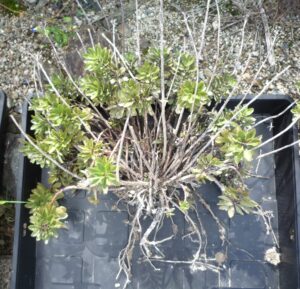

296日経過 1月 296 days passed January


362日経過 362 days have passed


479日経過 479 days have passed


まとめ summary
1年半経過後も根が露出し土壌が無い状態でも生育を続けている。
地植えに比べ株の拡大成長は無いが季節ごとに新芽が成長し緑化を継続している。
自然界で根が機能しない状態で479日経過声明を維持し、成長を継続できるのはサボテン類でも少ない。
四季彩4 キリンソウは、茎がタケシマキリンソウと同じく太く長い、新芽の発生は一般の植物では葉の基部より発芽・発根するが四季彩4キリンソウは株元に近い茎より多数出現する。株中心部から多数発生する不定根が降雨時に吸水を補っている可能性がある。一般にセダム類では週間単位で乾燥した根の吸水機能発現は、数時間から半日程度遅れて発現する。四季彩4キリンソウが置かれた環境では植物表面の付着水が蒸発するまでに給水する必要があり、乾燥根の吸水発現時間も短く機能している可能でも考えられる。また、成長に欠かせない肥料成分も雨水のみに含まれる成分に依存しているにもかかわらず年単位で成長維持できているのは驚異的である。
本実験を通じて、屋上緑化で危惧されている酷暑、土の風化、強風、少雨について四季彩4キリンソウは対処が可能であり、持続的な緑化が出来ると思われる。しかし生物である限り永続的な生存はできず、例えば1年点検のメンテナンス間隔を自立して生育できる事が証明されれば、屋上用緑化、壁面緑化、庭園緑化の維持管理が定期的なサイクルで固定化でき、屋上防水改修が有ってもその間移設するだけで、再設置可能となり維持管理の省力化と安心リスクの低減につながる。耐候性・生存限界試験にて、四季彩4キリンソウは常緑種であるが、冬至芽は秋季に成長するが、1cm以下で停止し、成長は春季に開始する事が判った。過酷な環境と極度に低下した肥料環境が、本来の成長サイクルを延滞させていると判断している。しかし、原種タケシマキリンソウの、冬至芽が秋季に成長を開始し冬季に2~5cm成長した段階で冬季を迎え、春季に再度成長を開始する常緑種の特性を、四季彩4キリンソウも生存限界に近い環境でも特性を発揮している事を示し、突然変異技術で作出した種であっても耐候性の良い特性を引き継いでいる証明になっている。
Even now, a year and a half later, the roots are still exposed, and the plant continues to grow even without soil.
Although the plant hasn’t grown as large as when it was planted in the ground, new shoots grow with each season, becoming greener and greener.
In nature, few cacti can maintain growth without developing roots for 479 days.Like Phedimus takesimensis( Nakai), Shikisai 4 Kirinsou has a thick, long stem. While new shoots typically sprout and root from the base of the leaves, Shikisai 4 Kirinsou produces many new shoots from the stem near the base of the plant. This suggests that the numerous adventitious roots may be supplementing water absorption during rainfall. Generally, sedums tend to have roots that dry out over several weeks, with the ability to absorb water delayed by several hours to half a day. In Shikisai 4 Kirinsou’s environment, the dry roots quickly absorb water before the water on the plant’s surface evaporates, allowing the plant to function normally.It is noteworthy that Shikisai No. 4 Kirinsou can maintain its growth for many years, relying solely on rainwater for the fertilizer it needs.This experiment demonstrated that Shikisai No. 4 Kirinsou has the ability to withstand environmental conditions that are of concern for rooftop greening, such as extreme heat, soil weathering, strong winds, and little rain, demonstrating the potential for sustainable greening. However, as a living organism, it cannot survive forever. For example, if it is proven that it can grow autonomously beyond its annual maintenance cycle, it will become possible to establish regular maintenance cycles for rooftop greening, wall greening, and garden greening. Even if rooftop waterproofing repairs are required, the plant can be simply moved and reinstalled during the repair work, reducing maintenance efforts and safety risks.
The results of weather resistance tests and survival limit tests revealed that although Shikisai No. 4 Kirinsou is an evergreen tree, its winter solstice buds grow in the fall, but stop at less than 1 cm, and resume growth in the spring. It is thought that the harsh environment and extremely low fertility slow down the natural growth cycle. However, in the original species, Phedimus takesimensis( Nakai) , winter solstice buds begin to grow in autumn, grow 2-5 cm over the winter, and then begin growing again in spring. This shows that Shikisai No. 4 Kirinsou exhibits these characteristics and becomes an evergreen tree even in an environment close to its survival limit. This proves that even species created using mutation technology can inherit excellent weather resistance characteristics.
第3回
酷暑・防風・豪雨にも負けない緑化植物「四季彩4キリンソウ」
四季彩4 キリンソウの成長に土壌が影響するかを調査した結果、周囲の土壌を取り除いても四季彩キリンソウは1年4ケ月成長を続けている。
周囲の土壌をふるい落とした状態で屋外に放置し、2024年3月27日から2025年7月24日1年4ヵ月経過しても成長を続ける生命力が確認できた。四季彩4キリンソウは令和7年7月品種登録31067号で、タケシマキリンソウ原種から化学突然変異技術で2013年に開発された新品種です。
その特性は、タケシマキリンソウの強健さに濃緑色の葉色を加えた緑の冴える品種です。
開発当初より優れた耐候性を示し、「植物は土壌が無ければ生育できない」常識を覆す「根が露出状態で生育できる」超耐候性を備えています。
四季彩4 キリンソウの「根が露出状態でも生育する」超耐候性の実力紹介
株元周辺の土壌ない場合を想定し、根周囲の土壌をふるい落とししても生育できるかの試験を実施
2024年3月27日 試験開始
根の周囲の土壌をふるい落とした四季彩4キリンソウをコンクリート上に移設し、試験開始した。
四季彩4の根は主根が四方に伸び細根が土壌を包む混みように成長している事から
根の伸長範囲の土壌をしっかり閉じ込め土壌の分離は難しく自然災害での土壌分離は少ない
Evergreen Kirinsou “Shikisai 4” – Characteristics Part 3
Shikisai 4: A Greening Plant that Withstands Extreme Heat, Strong Winds, and Heavy Rain
We investigated whether soil affects the growth of Shikisai 4. Even after removing the soil from around the roots, Shikisai 4 continued to grow for one year and four months.Even now, one year and four months later, from March 27, 2024 to July 24, 2025, it continues to grow with vitality.Shikisai 4 was registered in July 2025 under variety registration number 31067. It is a new variety developed in 2013 using chemical mutation technology from the original species of Takeshima Kirinsou.
In addition to the robustness of Takeshima Kirinsou, it features dark green leaves and a vibrant green color.Since its development, it has demonstrated excellent weather resistance, overturning the conventional wisdom that “plants cannot grow without soil,” boasting ultra-weather resistance that allows it to grow even with its roots exposed.We would like to introduce the ultra-weather resistance of “Shikisai 4 Kirinsou,” which can grow even with its roots exposed.Considering the lack of soil at the base of the plant, we conducted tests to determine whether the plant could grow even after shaving off the soil around the roots.
March 27, 2024
After shaving off the soil around the roots, the “Shikisai 4 Kirinsou” was transferred onto concrete and the test began.”Shikisai 4″ has a taproot that grows in all directions, with its thin roots enveloping the soil.This tightly confines the soil within the roots’ reach, making it less likely to separate and reducing the risk of soil separation during natural disasters.
2024年3月27日 試験開始
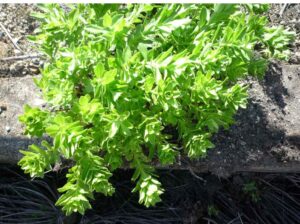

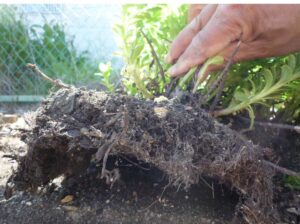

2025年5月3日 試験開始1年経過 緑化トレーに移設
試験開始から1年経過後に緑化トレーに移設。新芽の成長は地植えに比べ、遅れているが芽数はほぼ同数発生している。根系周囲からの土壌の流出も端部のみに限定され、根系内に残された空間で吸水し自立生長している。
Moved to greening trays on May 3, 2025
One year after the start of the test, the plants were moved to greening trays.New shoot growth was slower than in the ground, but the number of shoots was roughly the same.Soil loss from around the root system was limited to the edges, and water was supplied through the remaining space within the root system, allowing the plants to grow independently.
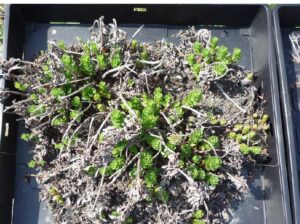



2025年7月24日 試験開始から1年4カ月経過
開花終了、開花数は非常に少ない。草丈は15cm以内と地植えの半分程度である。葉色は緑黄色で地植えに比べ黄色に変化している。これは水分・栄養分等の過少が原因と考えられるが、緑化に使用する耐候性植物として優秀な酷暑、低降水、低草丈、低開花、無肥料に耐え忍ぶ良い形態を示している。
July 24, 2025
One year and four months after the start of testing
Flowering has finished, with very few flowers. The plant height is less than 15 cm, about half that of the in-ground planted plant.The leaves are greenish-yellow, but have turned yellow compared to the in-ground planted plant. This is thought to be due to a lack of moisture and nutrients. However, this plant exhibits excellent morphology as a weather-tolerant plant for use in greening, able to withstand extreme heat, low precipitation, low plant height, low flowering, and no fertilizer.
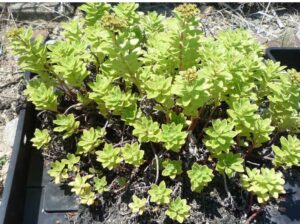


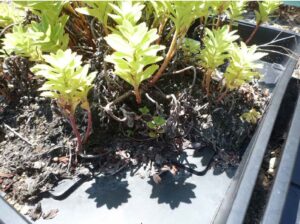

四季彩4 キリンソウは、原種のタケシマキリンソウは沿岸部の岩場に生息し、岩の隙間など根が張れる場所があれば生育が可能であり、土壌が無ければ生育できない野菜や観葉植物と異なる特異な生育をする。このため、キリンソウに対する土壌の作用は、成体の姿勢維持のための根張りと水分・養分の保持として寄与している。
The original species of Shikisai Kirinsou, Phedimus takesimensis , lives on coastal rocky areas and can grow wherever there is space for its roots to spread, such as between rocks, making it unique in its growth pattern, unlike vegetables and ornamental plants, which cannot grow without soil.For this reason, the function of soil for Phedimus takesimensis is to help it spread its roots to maintain its adult posture and to retain moisture and nutrients.
写真 新潟沿岸部岩場に自生しているキリンソウ
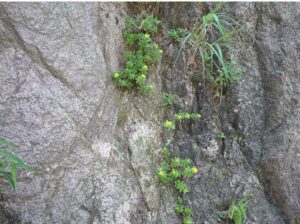

第4回
緑化でどれくらい涼しくなるのか?
Part 4: How much cooler can greening make the place?
温暖化は危険な暑さをもたらし酷暑・日照・少雨で2025年夏は屋上緑化植物に過酷です
2025年7月は異常高温が続き危険な暑さの報道が毎日繰り返されています。
エアコンの使用が増えている。2000年よりヒートアイランド防止で屋上緑化が盛んに取り入れられビルの屋上温度緩和に寄与していますが、強い日射と高温は植栽された緑化植物には過酷な環境が続いている。中でも2000年から2020年の屋上緑化の最も多く使われたセダム種は、耐高温特性の限界に近づいています。こうした緑化場所では潅水等の維持管理が必要となりまが、実際には無潅水・無管理での生育になっています。危険な暑さの中で緑化植物の表面温度は何度に達しているか見てみましょう。
Global warming is bringing dangerous heat, intense sunshine, and little rain.The summer of 2025 will be harsh for rooftop green plants.
July 2025 saw an unusually high temperature, with reports of dangerously hot weather repeated daily.Despite increased air conditioning use, rooftop greening has been widely adopted since 2000 to prevent the heat island effect. While rooftop greening has contributed to mitigating rooftop temperatures on buildings, intense sunlight and high temperatures continue to create harsh environments for green plants.Sedum species, the most commonly used rooftop greening from 2000 to 2020, are reaching the limits of their heat tolerance. While these greening areas require maintenance such as irrigation, they are actually growing without irrigation or care. Let’s take a look at how high the surface temperatures of green plants reach in these dangerously hot weather.
屋上緑化で使用されるセダム種の遮熱効果について
2つの場所について表面温度から効果を調査しました。
1 2017年8月17日 13時頃 東京都練馬市内
2 2025年7月 9日 12時頃 東京都台東区役所 屋上庭園
We investigated the heat-blocking effect of sedum species used in rooftop greening based on surface temperatures at two locations.
- August 17, 2017, around 1:00 PM, Nerima City, Tokyo
- July 9, 2025, around 12:00 PM, Taito Ward Office, Tokyo, Rooftop Garden
1 2017年8月17日 13時頃 東京都練馬
調査日 :2017年8月17日 13時頃
調査場所:東京都練馬
調査状況:露地に防草シートを張りその上に緑化容器(500×500×70)に培土厚40mmに植栽
調査方法:調査体より50cm距離の放射温度
測定器 :赤外線温度計 SATO 赤外線放射温度計 MODELSK-8940
植物年齢:挿し芽後半年
品 種:キリンソウ属:タケシマキリンソウ
セダム属 :メキシコマンネングサ、タイトゴメ、パリダム
- August 17, 2017, approximately 1:00 PM, Nerima, Tokyo
Survey Date: August 17, 2017, approximately 1:00 PM
Survey Location: Nerima, Tokyo
Survey Condition: Weed control sheet laid in the open field, with plants planted in a greening container (500 x 500 x 70 cm) with 40 mm of soil.Survey Method: Radiation temperature measured 50 cm from the test object.Measuring Instrument: Infrared Thermometer, SATO Infrared Radiation Thermometer MODEL K-8940 Plant Age: Six months after cutting.Species: Phedimus genus:Phedimus takesimensisSedum genus: Sedum mexicanum, Sedum pallidum, Sedum pallidum.
調査月のアメダス情報


調査結果
| 測定場所 | 温度(℃) | 地面との温度差(℃) |
| ユニット外周プラスチック表面温度: | 69.9 | 10.3 |
| 露地張り防草シート上: | 64.2 | 4.6 |
| 枕木上: | 58.1 | -1.5 |
| 地面表面: | 59.6 | 0.0 |
| タケシマキリンソウ表面温度: | 33.9 | -25.7 |
| メキシコマンネングサ表面温度: | 41.4 | -18.2 |
| タイトゴメ表面温度: | 43.0 | -16.6 |
| パリダム表面温度: | 51.9 | -7.7 |
地面温度に比べ植物種により異なる発熱温度


土壌温度を100%とした場合の、各植物の温度低減率(%)
タケシマキリンソウ :-34.2%
メキシコマンネングサ:-30.5%
タイトゴメ :-27.8%
パリダム :-12.9%
測定写真
土壌表面温度:59.6℃ 枕木上表面温度:58.1℃
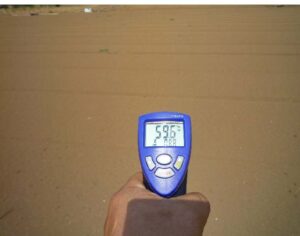

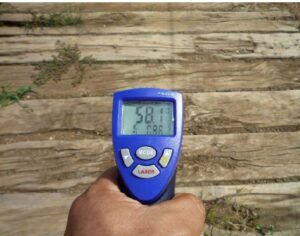

防草シート上表面温度:64.2℃ 緑化容器外周プラスチック表面温度:69.9℃
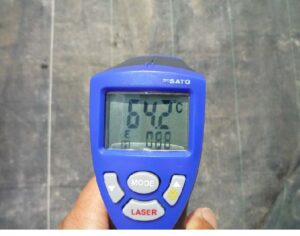



タケシマキリンソウ表面温度:33.9℃


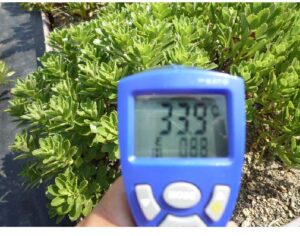

メキシコマンネングサ表面温度:41.1℃
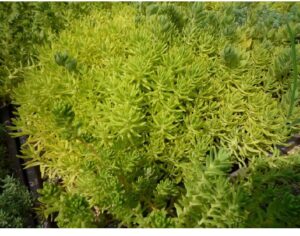

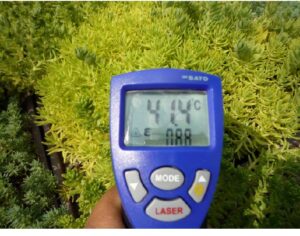

タイトゴメ表面温度:43.0℃


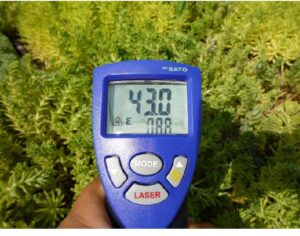

パリダム表面温度:51.9℃
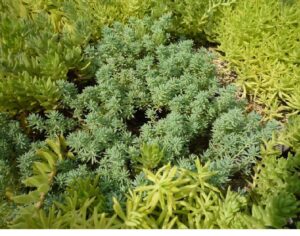

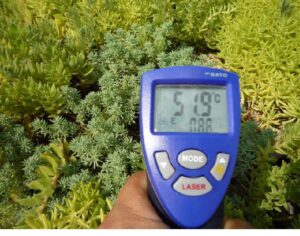

2 2025年7月9日 東京都台東区役所 屋上庭園
調査日 :2025年7月9日 12時頃
調査場所:東京都台東区役所 屋上庭園
調査状況:緑化区画内に各社出典展示
調査方法:調査体より50cm距離の放射温度
測定器 :赤外線温度計 SATO 赤外線放射温度計 MODELSK-8940
植物年齢:8年前後
品 種:タケシマキリンソウ、スナゴケ、ユッカ類、芝、ペチュニア、混合植栽
- July 9, 2025, Rooftop Garden, Taito Ward Office, Tokyo
Survey Date: July 9, 2025, approximately 12:00 PM
Survey Location: Rooftop Garden, Taito Ward Office, Tokyo
Survey Status: Various company exhibits within the green space
Survey Method: Radiation Temperature of the Test Object
Measuring Instrument: Infrared Thermometer, SATO Infrared Radiation Thermometer MODELSK-8940
Plant Age: Approximately 8 yearsVarieties: Phedimus takesimensis, Sunagoke moss, yucca, grass, petunia, mixed planting
表面温度調査結果
屋上表面温度は(セラミック部分)62.4℃と高温で有ったが、四季彩キリンソウ表面温度は31.8℃に対し、コケ緑化表面は63.6℃と屋上表面温度とほぼ同じであった。ユッカ等の大型立性種サボテンでは25.9℃と低い値を示した。
灌水区では、26.3℃から45.5℃と四季彩キリンソウとほぼ同じ値の範囲に収まる。
この結果より、潅水を行えばガーデンプランツでも生育できるが、蒸散量の激しい芝類は潅水設定を誤ると枯損が発生する危険性が高い。
キリンソウの表面温度と地面温度と差は、2017年8月17日地上13時頃 東京都練馬結果:-25.7℃
2025年7月 9日 東京都台東区役所 屋上庭園:-30.6℃の温度差が出る。
| 場所 | 表面温度 | 温度差 |
| 設置場所温度 | 62.4 | – |
| 無潅水 四季彩キリンソウ緑化 | 31.8 | -30.6 |
| 無潅水 コケ緑化 | 63.6 | -1.2 |
| 無潅水 ユッカ類 | 25.9 | -37.7 |
| 灌水区 枯れた芝緑化 | 45.5 | -16.9 |
| 灌水区 混合緑化区 | 38.1 | -24.3 |
| 灌水区 ペチュニア | 26.3 | -36.1 |
Surface Temperature Survey Results
The rooftop surface temperature (ceramic portion) was high at 62.4°C. However, the surface temperature of the Shikisai Kirinsou was 31.8°C, while the moss-covered surface was 63.6°C, almost the same as the rooftop surface temperature. Large upright cacti such as yucca showed a lower temperature of 25.9°C.
In the irrigated area, temperatures ranged from 26.3°C to 45.5°C, roughly the same as the Shikisai Kirinsou.From these results, garden plants can grow with irrigation, but turf grasses, which transpire significantly, are at high risk of withering if irrigation settings are incorrect.The difference between the surface temperature of the Kirinsou and the ground temperature was -25.7°C at around 1:00 PM on August 17, 2017, in Nerima, July 9, 2025, Taito Ward Office Rooftop Garden, Tokyo: Temperature difference of -30.6℃.




潅水設備なし 無灌水区
植栽植物の表面温度 62・4℃ 無潅水 四季彩キリンソウ緑化 31.8℃
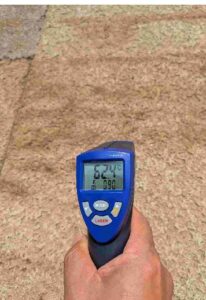

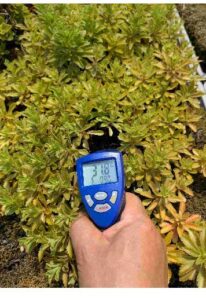

無潅水 コケ緑化 63.6℃ ユッカ類 25.9℃
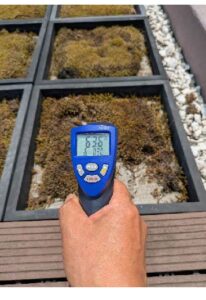

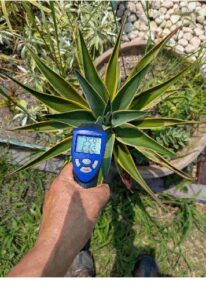

灌水設備有 灌水区
灌水区 枯れた芝緑化 45.5℃ 灌水区 混合緑化区 38.1℃
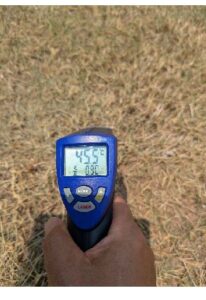



灌水区 ペチュニア 26.3℃


第5回
四季彩4キリンソウの高温に対する耐性
Part 5 “Shikisai 4” to High Temperatures
令和7年7月18日 種苗登録(番号31057号)四季彩4キリンソウの高温耐性について解説する。7月25日も日本各地で危険な暑さになった。この暑さは涼しいはずの北海道でも発生しの報道されました。
This article explains the heat tolerance of the weather-tolerant, Phedimus takesimensis (Nakai) ‘t Hartwhich was registered as a Seedling registration(No. 31057) on July 18, 2025.Today, July 25th, is once again a dangerously hot day in many parts of Japan. This heatwave is even occurring in Hokkaido, which is supposed to be cooler, and has been reported.
7月24日【帯広市40℃予想】経験したことがない危険な暑さ 昼過ぎの外出は極力控えて!17時過ぎまで35℃以上【北海道の天気 24日(木)】
【最新】最高気温40℃予想の北海道帯広市で“暑さに耐えられず”JR駅前の温度計の表示消え“真っ黒”に_観測史上1位タイとなる28.8℃を観測 UHB北北海道文化放送より
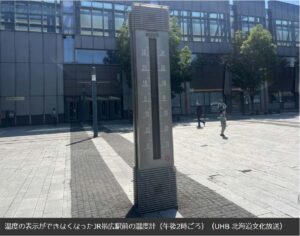

植物の世界に目を向けると、これまで園芸に使われてきた植物は、生育域分布から植栽適地を判断し使用してきた。適正適地と思われた植栽植物も、急激な温暖化で高温・日照の影響から生育障害が散見できるようになった。原因は気温の上昇が最も強く、これに伴う日照で代謝不良が生じ成長不良や枯死に至る事態が発生している。特に建築物屋上を緑化する代表種の芝、カバープランツ類は潅水装置が必須となり、セダム類、キリンソウ類では適正生育温度帯から外れて生育不良になる品種が発生している。しかし、ビルの屋上や工場の屋根を緑化するいわゆる特殊環境緑化植物は、その代わりになる植物が見当たらない。そうなると耐性の強い植物を開発する必要がある。
酷暑に強い耐候性品種を作るには、2種類の方法があります。
1つ目は、一般によく使われる交配で作成する方法がある。この方法で作成した品種は、親の形質以上に高い特性は望めず、耐性品種を作るには耐候性の高い親を探す事が必要となる。
2つ目は、突然変異技術で耐候性を示す遺伝子部分を変化させて、耐候性の高い遺伝子を持った品種を作成する方法がある。
突然変異は自然界でも起き、自然界では目的とする特性の発生率は、京の単位ほど小さい事が判っている。そこで人工的に自然で発生する突然変異と同じ方法で作成したのが四季彩4キリンソウです。方法は、耐候性の高いタケシマキリンソウを耐候性に絞った目標で化学突然変異技術で作成し、クローン技術で量産したのが「四季彩4キリンソウ」です。四季彩4キリンソウは、タケシマキリンソウを使って2013年超耐候性を目標に開発した「常緑性タケシマキリンソウ」の突然変異種で優れた高温耐性と乾燥耐性を備えています。
Looking at the world of plants, plants that have been used in gardening up until now have been selected for planting based on their habitat distribution. However, even plants that were planted in a suitable location are now being found to be suffering from growth problems due to the high temperatures and sunlight caused by the rapid warming of the planet.The main cause is rising temperatures, with sunlight causing poor metabolism, leading to poor growth and death.
Irrigation systems are particularly essential for the typical grasses and cover plants used to green building rooftops, and some sedum and Phedimus takesimensis varieties are growing poorly due to temperatures outside their optimum range.However, no alternative plants can be found for the so-called special environment greening plants used to green building and factory roofs. This means that it is necessary to develop plants that are more tolerant.
There are two methods for creating weather-resistant varieties that can withstand extreme heat.The first is the commonly used method of crossbreeding, but varieties created using this method cannot be expected to have characteristics superior to those of the parents, so the first step is to find parents with high weather tolerance.The second method is to use mutation technology to alter the genetic parts that indicate weather tolerance, creating a variety with highly weather-resistant genes.Mutations do occur in nature, but the actual occurrence rate of desired characteristics is known to be on the order of quintillions. Therefore, Shikisai 4 Kirinsou was created by artificially inducing mutations using the same method as natural mutations.The highly weather-resistant Phedimus takesimensis was created using chemical mutation technologyto specifically target weather resistance, and then the evergreen Kirinsou was completed using cloning technology: Shikisai 4 Kirinsou.Shikisai 4 Kirinsou is a mutant variety of the evergreen Phedimus takesimensis , which was developed in 2013 using Phedimus takesimensis with the goal of achieving ultra-weather resistance, and has excellent heat and drought tolerance.
四季彩4 キリンソウの高温特性
2025年7月25日14時 岡山県津山市状況で生育する四季彩4キリンソウ
High-temperature characteristics of Shikisai 4 Kirinsou
July 25, 2025, 2:00 PM, Tsuyama City, Okayama Prefecture. Shikisai 4 Kirinsou growing under these conditions.
雲が20%程度ある」晴天日 室内気温34℃




スレート屋根表面温度64.2℃ カラー鋼板屋根66.5℃


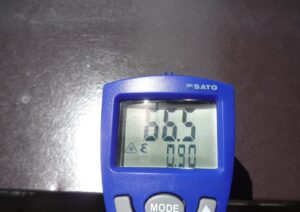

屋上緑化容器表面温度68.2℃ アスファルト表面温度66.6℃


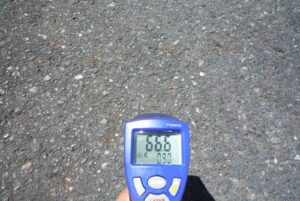

四季彩4キリンソウ温度34.7℃


四季彩4 キリンソウは、気温34℃、屋外のアスファルト66.6℃、カラー鋼板上66.5℃と屋上緑化の緑化容器66℃に達した環境でも四季彩キリンソウ表面温度は34.7℃と周囲より30度近く低い遮熱効果を出し正常に成長している。
四季彩4 キリンソウが高温・日照でも耐えられるのは、一般にCAM植物で日中気孔を閉じて蒸散を止める特性によると言われるが、年単位の長期間にわたり少降雨・高温・低温にも耐える事ができるには、強力なホルモン作用と葉・茎内に蓄積する事の出来る養分・水分をつかさどる代謝機構と、それを保持する葉内の細胞壁の構造による結果と推定している。特に植物ホルモン アブシジン酸の作用の仕方が、他の植物に比べ顕著に作用し長期の耐候性を出すと推定している。
写真の雨水のみで1年4カ月経過 高温にさらされる四季彩4キ リンソウは、耐候性状態に入った葉の状態(濃緑色➞黄緑色)を示している。この黄緑色が耐候性のスイッチが入った植物体内の代謝を最小限に抑え耐えるモードに切り替えた事を表しています。
2025年7月24日
雨水のみで1年4カ月経過 高温にさらされる四季彩4キリンソウ
開花終了期であるが、開花数は非常に少ない。草丈は15cm以内と地植えの半分程度、葉色は黄緑色で地植えに比べ黄色がかる。これは耐性状態にある事を表し、高温・日照・水分・栄養分等の悪条件に耐える草姿を現している。特殊環境緑化に使用する耐候性植物の酷暑、低降水、低草丈、低開花、無肥料に耐え忍ぶ良い形態を示している。
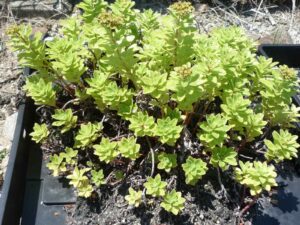

Shikisai 4 Kirinsou
Even in environments where the temperature reached 34°C, 66.6°C on outdoor asphalt, 66.5°C on colored steel sheets, and 66°C in a rooftop greening container, Shikisai 4 Kirinsou maintained a heat-blocking effect of 34.7°C, nearly 30°C lower than the surrounding area, and continued to grow normally.
Shikisai 4 Kirinsou’s ability to withstand high temperatures and sunlight is generally believed to be due to the characteristic of CAM plants, which close their stomata during the day to stop transpiration. However, its ability to withstand low rainfall, high temperatures, and low temperatures over long periods of time, measured in years, is believed to be the result of powerful hormone action, a metabolic mechanism that controls the nutrients and water that can accumulate within the leaves and stems, and the structure of the leaf cell walls that retain them.
In particular, it is believed that the plant hormone abscisic acid works more significantly than in other plants, resulting in its long-term weather tolerance.The photo of Shikisai 4 Kirinsou shows the leaves in a weather-tolerant state (dark green to yellow-green).This yellow-green color indicates that the weather resistance switch has been turned on and the plant has switched to a weather-resistant mode that minimizes metabolism within the plant’s body.
July 24, 2025
After 1 year and 4 months outdoors, Shikisai 4 Kirinsou has been exposed to high temperatures.Flowering has finished, and the number of flowers is very small. The plant height is less than 15cm, about half that of plants planted in the ground.The leaf color is yellow-green, more yellowish than plants planted in the ground. This indicates a tolerant state, demonstrating the plant’s ability to withstand adverse conditions such as high temperatures, sunlight, moisture, and lack of nutrients.As a weather-tolerant plant used for special environment greening, it exhibits a good morphology that can withstand extreme heat, low precipitation, low plant height, low flowering, and no fertilizer.
地球環境は近年急速に温暖化に極端化に拍車がかかっています。
過酷な建築物屋上環境を緑化する屋上緑化で想定される事は、これまで使用していたセダム類や一部のキリンソウで環境耐性が限界を迎え、ある時期に突然緑化維持が困難な状態が予想されます。四季彩4 キリンソウは発生する気象条件の克服を目指して開発種です。耐久性能は順次発表していきますのでご覧ください。
四季彩4 キリンソウは広く普及を目指し、タケシマキリンソウ市販同等の価格で販売をめざしています。暑熱環境に関心がある方は検討される事を願っています。
In recent years, global warming has become increasingly extreme.
When greening the harsh rooftop environments of buildings, it is expected that the sedum species and some types of Phedimus takesimensis that have been used until now will reach their environmental limits, and at some point it will suddenly become difficult to maintain the greenery.Shikisai 4 Kirinsou was developed to overcome the weather conditions that may arise.Durability performance will be announced in due course, so please stay tuned.iming for widespread adoption of Shikisai 4 Kirinsou, we aim to sell it at the same price as the commercially available Takeshima Kirinsou. We hope that anyone interested in hot environments will consider it.
第6回
四季彩4キリンソウの色調と新芽の成長の仕方
四季彩4キリンソウはタケシマキリンソウの突然変異種の中でもっとも濃緑色品種です。
濃緑色は5月成長終了期より際立ちます。栄養状態や極度に耐性状態では葉色が黄緑色に変化する場合も有ります。
Evergreen Kirinsou “Shikisai 4” Characteristics Explanation, Part 6
Shikisai 4 Kirinsou Color Tone and Shoot Growth
Shikisai 4 Kirinsou is the darkest green variety among the Takeshima Kirinsou mutants.The dark green color becomes more pronounced after the growth period ends in May.In vegetative or extremely resistant conditions, the leaf color may turn yellow-green.
左:タケシマキリンソウ 右:四季彩4 キリンソウ



開花期の黄色花と濃緑色葉のコントラスト
The contrast between the yellow flowers and dark green leaves during flowering


2025年7月24日
雨水のみで1年4カ月経過 高温にさらされる四季彩4 キリンソウ
葉色は黄緑色で地植えに比べ黄色がかる。これは耐性状態にある事を表し高温・日照・水分・栄養分等の悪条件に耐える草姿を現している。
July 24, 2025
After 1 year and 4 months of watering with only rainwater, this Shikisai 4 Kirinsou plant is exposed to high temperatures.
The leaves are yellow-green, more yellowish than those planted in the ground. This indicates a resistant state, allowing the plant to withstand adverse conditions such as high temperatures, sunlight, moisture, and nutrient shortages.



新芽の成長の仕方
四季彩4 キリンソウの年間成長サイクルは、タケシマキリンソウの成長サイクルと合致しています。
新芽は秋に成長を始め冬至芽(翌年に成長する芽)が成長し、冬季に前年成長した枯れ枝葉と入れ替わり冬季でも緑の新芽が見えます。4月になると盛んに成長し6月頃には開花期を迎え、濃緑の葉と濃い黄色の花が咲きコントラストが冴え綺麗な緑化となります。酷暑期は枯れる事無く経過し、秋に来年生育する新芽の生長が始まる一年のサイクルを、根が露出していても継続できる耐久性の高い成長をします。
How New Shoots Grow
The annual growth pattern of Shikisai 4 Kirinsou corresponds to the growth cycle of Takeshima Kirinsou.
New shoots begin to grow in the fall, and in winter, the branches and leaves that grew the previous year die off and are replaced by winter solstice buds (buds that will grow the following year). The plant’s height changes, and green new shoots are visible even in winter. Growth vigorously increases in April, and the flowering season begins around June, with the dark green leaves and deep yellow flowers creating a striking contrast, creating a beautiful green landscape. The plant survives the heatwaves without dying, and even with exposed roots, it continues its annual growth cycle, continuing even in the fall when new shoots that will grow the next year begin to grow.
10月27日
October 27th
来年春に成長する新芽が成長開始
Sprouts that will grow next spring start to grow


12月19日
December 19th
氷点下10度でも枯死しない。この状態を常緑と表現している場合がある
Will not die even at minus 10 degrees This state is sometimes referred to as evergreen.


1月24日
冬至芽(越冬する新芽)が成長を始める
Winter solstice buds (overwintering buds) begin to grow
タケシマキリンソウの前年成長した葉は特殊ケースでは枯死しない事がある。たとえば春以降に挿し木をして冬を経験していない成長した枝は、葉が生き残る場合が多い。
In special cases, leaves that grew the previous year on Phedimustakesimensis may not wither and die. For example, leaves often survive on grown branches that have been propagated after spring and have not experienced winter.
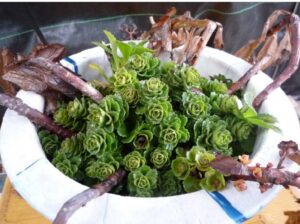

3月21日
草丈8cm付近まで成長
Grows up to around 8 cm tall
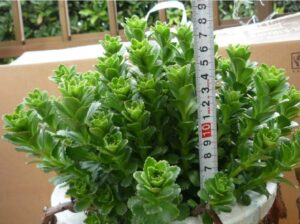

タケシマキリンソウ種は、条件により落葉せず残る場合がある。これらは植栽地域や、栽培環境・栽培開始時期などの要因が有るが、日本本土では一般に当年春に成長した葉は枯れる状況が多い。来年成長する芽が秋に成長し、枯れる枝葉と交代して緑が耐えない状況を昔より常緑あるいは常緑性と呼んでいた。
Depending on the conditions, the Phedimus takesimensis species may retain its leaves. This depends on factors such as the planting area, cultivation environment, and when cultivation began, but in mainland Japan, the leaves that grew in the spring of the current year generally wither.The condition in which buds that will grow next year grow in the fall, replacing the withered branches and leaves and remaining green has long been called “evergreen” or “evergreen.”
第7回
キリンソウの「常緑」とはどんなこと?
キリンソウのカタログやインターネット情報には、よく「常緑」という言葉が出てきます。
キリンソウの常緑についてよく質問があります。ここではどんな現象を指しているのか見ていきましょう。キリンソウの常緑とは、どのような草姿をいうのでしょうか?「常緑」言葉から想像するのは、常緑樹のような年中緑の葉を茂らせるイメージではないかと思いますが、キリンソウに言われる「常緑」とは少し違った仕組みの緑の状態を言います。現象の解説はキリンソウの権威者 東京都市大学 飯島健太郎教授か書かれたコラム「緑化植物ど・こ・ま・で・き・わ・め・る 常緑性キリンソウ」で解説されているので紹介いたします。
Evergreen Kirinsou “Shikisai 4” – Characteristics Explanation, Part7
What does “evergreen” mean when it comes to Phedimus takesimensis?The word “evergreen” often appears in catalogs and online information about Phedimus takesimensis.We often receive questions about the evergreen nature of Phedimus takesimensis. Here, we’ll look at what phenomenon it refers to.What kind of plant does “evergreen” mean in Phedimus takesimensis?When you hear the word “evergreen,” you probably imagine lush, green leaves year-round, like an evergreen tree.This refers to a slightly different type of green state than the “evergreen” described for Phedimus takesimensis.This refers to a green state that is slightly different from the “evergreen” described in Phedimus takesimensis.The phenomenon is explained in the column “Where can we discover greening plants – Evergreen takesimensis” written by Professor Kentaro Iijima of Tokyo City University, an authority on Phedimus takesimensis, so we would like to introduce it here.




第8回
高温に耐える屋上緑化植物にする培土の工夫
高温障害が発生しそうな時の対策
Tips for growing high-temperature-resistant rooftop plants
Measures to take when high-temperature damage is likely to occur
植栽用の培土はどのような仕様により作られているのでしょうか? 最重要なコスト、排水性・透水性・保水性・軽量・肥料持ちを考えて設計されています。
特に屋上緑化や壁面緑化に使用する培土は各社特性を競って独自の配合で作っていますが、大きく分けると、透水性を重視した軽量化培土と、根張りを重視した団粒化培土に分けられます。
いずれの培土も使用開始から1年程度は初期の性能を発揮しますが、1年程度を経過すると肥料成分が溶脱し、組成成分の特性が表に現れ生育に影響を表し始めます。培土の衰退は、温暖化の伴う梅雨時期から紅葉時期までの高温化と冬季の温暖化により、培土中の肥料成分の溶脱・分解促進、有機成分の分解と連鎖しpHの変化は予想より早く変化します。中でも高温による生理障害で特に影響が現れる現象に、新葉が成長不良を起こし、黄変や枯れる現象です。これは肥料中のカルシウム 欠乏により引き起こされる現象です。
カルシウム欠乏は、酷暑や日照、少雨により土壌水分が低下し根が給水できなくなる場合や、未熟肥料の分解が起こすときに見られるカリウムや アンモニア態窒素が過剰になる事で、根から吸収されるカルシウムが減 少し発生するといわれています。また、温暖化による酷暑や日照、少雨で土壌が乾燥したとき葉枯れ症状を現す生理障害の一 つとされています。カリウム欠乏も起因の一つとされ降雨によってカリウムが流亡することや、カルシウ ム、マグネシウムとのバランスの崩れによって発生する場合が多くみられます。
これらの減少を緩和するには、暑熱対策として緩効性カルシウムを培土に配合する必要があります。屋上緑化は施工後10年以上を目標に継続緑化としています。カルシウム成分は長期緑化するには自然由来のカキガラ粉砕粉などの有機カルシウム材を混ぜるのが有効でしょう。有機カルシウム材は植物にかかっても害が無いので、高温障害の可能性がある現場ではメンテナンス時に散布が有効です。散布量は2~3握り1㎡程度を参考に実情に合わせて増減します。
What specifications are used in potting soil for planting? It is designed with cost, the most important of which is drainage, permeability, water retention, light weight, and fertilizer retention, all in mind.
In particular, various companies compete to create unique compositions for potting soil used in rooftop and wall greening, but broadly speaking, they can be divided into lightweight potting soils that emphasize permeability and granular potting soils that emphasize root development.Both types of potting soil will perform at their initial performance level for about a year after use, but after that, the fertilizer components will leach out, and the characteristics of the components will become apparent and begin to affect growth.Potting soil deteriorates due to the increasing temperatures from the rainy season through to the autumn foliage season and the warmer winter temperatures associated with global warming, which cause the leaching and decomposition of fertilizer components in the soil, resulting in the decomposition of organic components and changes in pH more quickly than expected.One physiological disorder particularly affected by high temperatures is stunted growth, yellowing, and wilting of new leaves. This is caused by a calcium deficiency in the fertilizer. Calcium deficiency is thought to occur when soil moisture levels drop due to extreme heat, sunshine, or little rain, preventing roots from hydrating, or when excess potassium and ammonia nitrogen, as seen when immature fertilizer decomposes, reduce calcium absorption by the roots. Potassium deficiency, a physiological disorder that causes leaf wither when the soil dries out due to extreme heat, sunshine, or little rain caused by global warming, is also thought to be a cause. This is often caused by potassium leaching due to rainfall or an imbalance with calcium and magnesium.
To mitigate this decline, slow-release calcium needs to be incorporated into the growing soil as a heat countermeasure. The goal for rooftop greening is to maintain greenery for at least 10 years after construction. For long-term greening, it is effective to mix in organic calcium materials such as natural ground oyster shell powder. Organic calcium materials are not harmful to plants even if they come into contact with them, so it is effective to spray them during maintenance at sites where there is a possibility of heat damage. The amount to be sprayed should be around 2-3 handfuls per square meter, and can be increased or decreased depending on the actual situation.
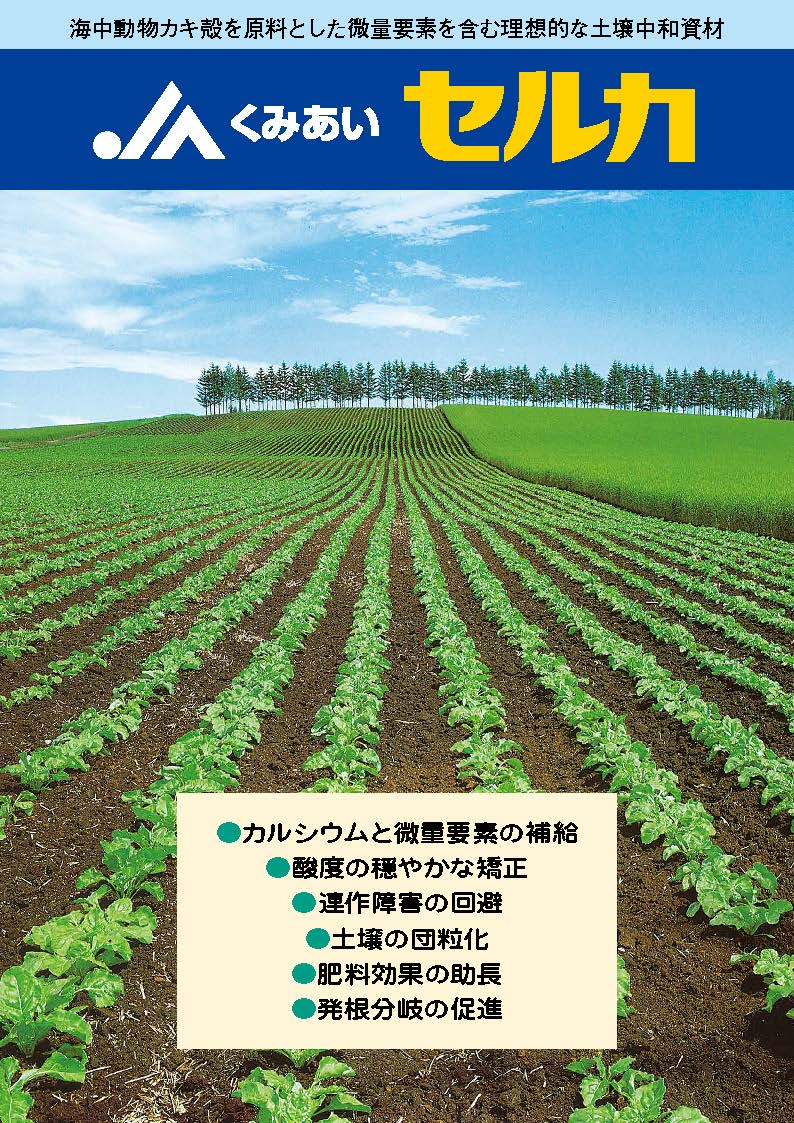

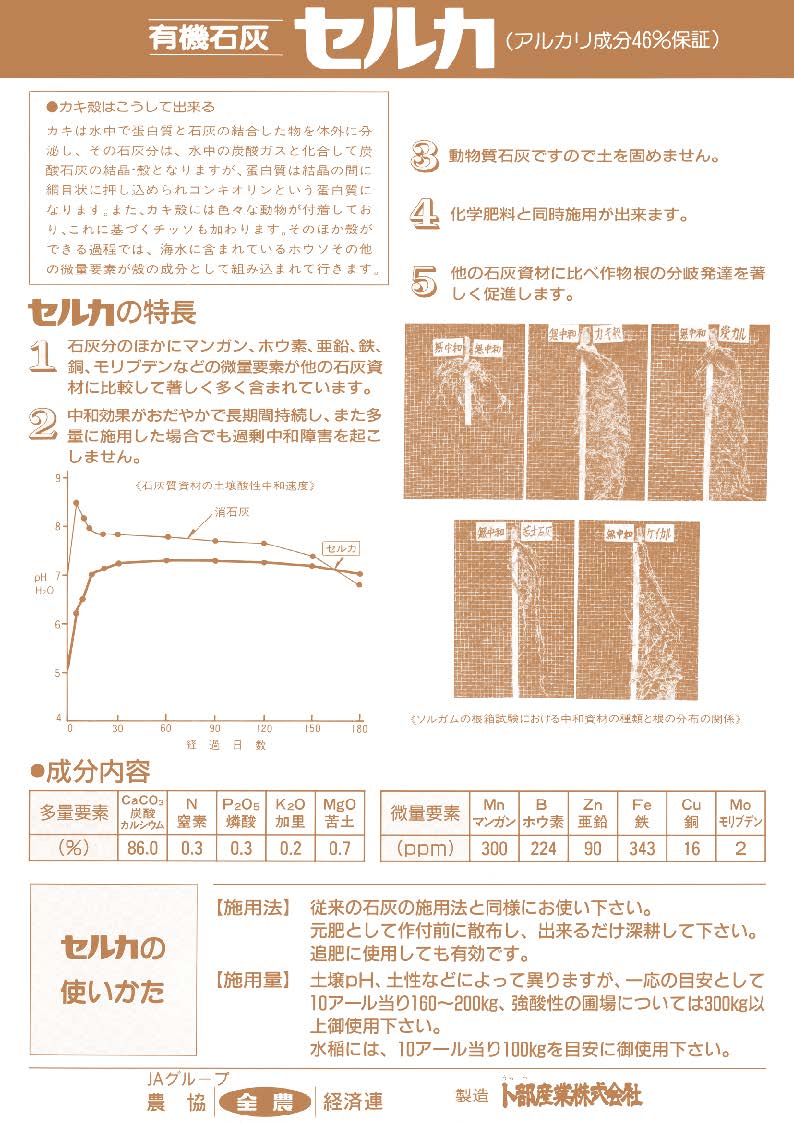



2025年8月19日
屋上緑化システム株式会社
技術顧問 山下 律正
Technical Advisor: Ritsumasa Yamashita
新着記事
キリンソウ・セダム屋上緑化の「冬支度と冬の管理」
キリンソウ、セダム類の屋上緑化・壁面緑化 春と秋の挿し芽増殖方法
キリンソウ・屋上緑化・壁面緑化 秋のメンテナンス 甲虫害編
キリンソウ・屋上緑化・壁面緑化 秋のメンテナンス 肥料編
屋上緑化の源風景 災害から屋根を守る知恵が育んだ「芝棟」
四季彩4 キリンソウ 総合技術カタログ A new variety, Shikisai 4 Kirinsou,General Technical Catalog
常緑性キリンソウ「四季彩4」 種苗登録認定 特性解説 第5回 キリンソウの常緑とは?
常緑性キリンソウ「四季彩4」 種苗登録認定 特性解説 第4回 根が露出し裸の状態で、酷暑・防風・豪雨に負けない耐久試験
常緑性キリンソウ「四季彩4」 種苗登録認定 特性解説 第3回 酷暑に耐える緑化植物が受ける温度の影響
常緑性キリンソウ「四季彩4」 種苗登録認定 特性解説 第1回 濃緑色で色彩が冴える



